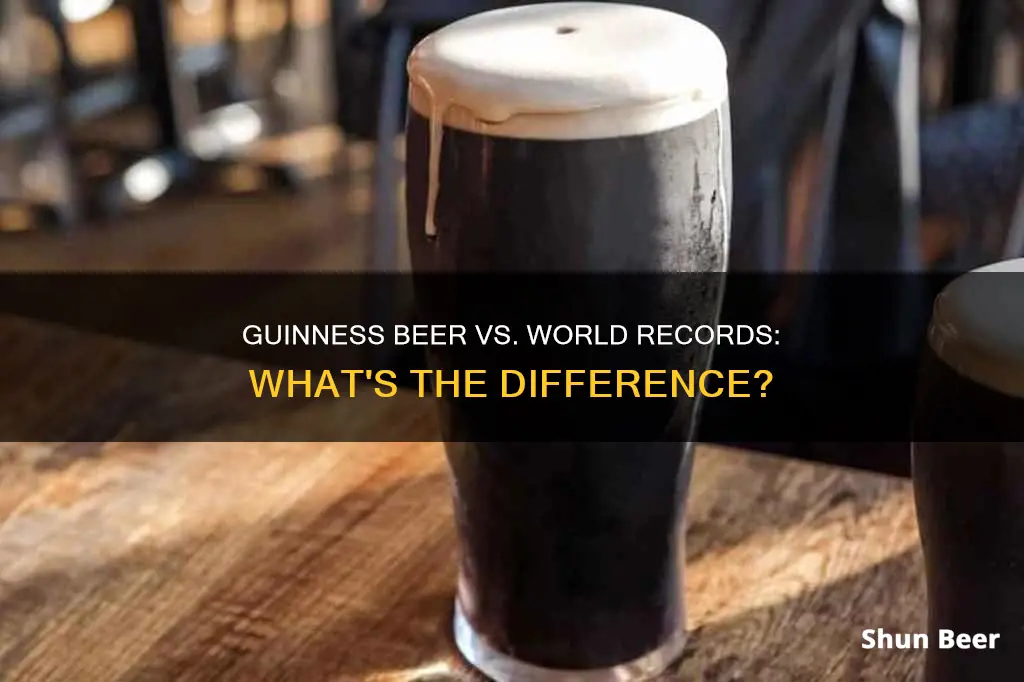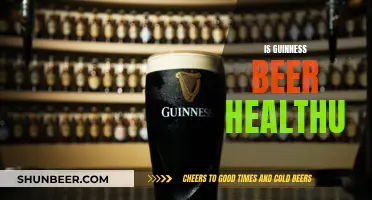
Guinness World Records, originally known as the Guinness Book of Records, was started by the director of Guinness Breweries, Sir Hugh Beaver, in 1951. The idea for the book came about when Beaver and his friends were involved in an argument about the fastest game bird in Europe and couldn't find the answer in any reference book. Beaver then decided to create a book of facts to settle pub disputes and arguments. The book was first published in 1955 and became a bestseller in the UK and later, internationally. While Guinness World Records and the beer company are no longer officially linked, the former was indeed started by the latter.
| Characteristics | Values |
|---|---|
| Original Guinness World Records Name | Guinness Book of Records |
| Year of Inception | 1955 |
| Founder | Sir Hugh Beaver |
| Co-founders | Norris and Ross McWhirter |
| Original Purpose | Settling pub arguments |
| Guinness Link | Managing Director of Guinness Brewery |
| Guinness World Records Owner | Jim Pattison Group |
| Guinness World Records Headquarters | London |
| Guinness World Records Book Sales | 150 million+ |
| Guinness World Records Countries | 100 |
| Guinness World Records Languages | 23 |
What You'll Learn
- Guinness World Records was founded by Guinness Brewery's managing director, Sir Hugh Beaver, in 1951
- The book was initially created to settle pub disputes
- The first edition was published in 1955
- Guinness World Records is now a global brand
- Guinness World Records is no longer affiliated with the beer company

Guinness World Records was founded by Guinness Brewery's managing director, Sir Hugh Beaver, in 1951
Guinness World Records, originally known as the Guinness Book of Records, was founded by Sir Hugh Beaver, the managing director of Guinness Brewery, in 1951. The idea for the book series first came about in the early 1950s when Beaver attended a shooting party in County Wexford. There, he and his companions argued about the identity of the fastest game bird in Europe and could not find the answer in any reference book.
In 1954, Beaver recalled this debate and decided to produce a book that could settle similar disputes. He hired Norris and Ross McWhirter, fact-finding researchers from Fleet Street, to compile a book of facts and figures. The book was initially intended to be given away for free in pubs to promote the Guinness brand, but it proved so popular that the company started selling it, and it became a best-seller.
The first edition of the Guinness Book of Records was published in Great Britain on August 27, 1955, and quickly became a hit. It featured a wide range of feats related to humans and animals. An American edition was released in 1956, followed by editions in several other countries. The McWhirters travelled the world to research and verify records.
Today, Guinness World Records is a global brand with offices in several major cities around the world. It continues to document record-breaking achievements through its annual book publications, TV shows, social media, and live events.
Guinness Beer: Healthy or Harmful?
You may want to see also

The book was initially created to settle pub disputes
The Guinness Book of World Records was created by the director of Guinness Breweries, Sir Hugh Beaver, in 1951. The goal was to create a resource to settle pub disputes and debates throughout Britain and Ireland. The idea first came to Beaver during a bird hunting trip in 1951 when he and his companions wondered about the fastest game bird in Europe. They could not find the answer in any reference book. Beaver soon realised that there was no single official record of the fastest game bird or much of anything else, for that matter.
Beaver hired researchers Norris and Ross McWhirter, twin sons of a newspaper editor, to work at his new company, Guinness Superlatives, which began operations on November 30, 1954. The brothers worked tirelessly to research various facts, working 90-hour weeks for several months. The book was published on August 27, 1955, and was initially intended as promotional material for the Guinness Brewery. 1,000 copies, laminated to protect against beer spillage, were distributed to local British pubs. However, the book proved to be so popular that Beaver began selling it to the public. An additional 50,000 copies were printed, and by Christmas of 1955, the Guinness Book of Records was a bestseller in the United Kingdom.
The book was so successful because it tapped into a public curiosity about world records. People did not just want to know who and what held records; they wanted to set records of their own. The Guinness Book of World Records is now a household name and the book has sold over 150 million copies worldwide, educating readers in over 40 languages.
Guinness Beer and Coffee: What's the Connection?
You may want to see also

The first edition was published in 1955
The Guinness Book of World Records, or Guinness World Records, was first published in 1955. The idea for the book was conceived in 1951 by Sir Hugh Beaver, the then managing director of Guinness Breweries. Beaver was on a hunting trip and missed a shot at a game bird. This led to a discussion among his party about the fastest game bird in Europe. Unable to find the answer in any reference book, Beaver realised there was a gap in the market for a book that could settle pub arguments about records.
Beaver's idea came to fruition with the help of Norris and Ross McWhirter, journalists who were also brothers. Together, they amassed records into a book, which was published in the summer of 1955. 50,000 copies of the book were distributed for free in pubs across Britain and Ireland as a promotional asset for the Guinness brand. The book soon became immensely popular and was often stolen from pubs.
The first edition of the Guinness Book of Records was 198 pages long and featured a deep green cover, golden lettering, and the Guinness harp logo. It topped the bestseller list in the United Kingdom by Christmas 1955 and became a global hit the following year. Since then, Guinness World Records has become a household name and the ultimate authority on record-breaking.
Guinness Beer: German or Irish?
You may want to see also

Guinness World Records is now a global brand
Guinness World Records, or GWR, is now a global brand, with a presence in over 100 countries and in 23 languages. The brand has come a long way since its inception in 1955, when it was known as 'The Guinness Book of Records'.
The idea for the book was conceived in 1951 by Sir Hugh Beaver, then the managing director of Guinness Breweries. On a shooting party, Beaver and his companions became embroiled in a debate about the fastest game bird in Europe. Unable to find a source to settle the argument, Beaver realised there was a gap in the market for a book that could provide answers to such questions. With the help of Norris and Ross McWhirter, journalists and brothers, Beaver compiled records into a book that was published in 1955.
The book was initially intended as a promotional item for the Guinness brewery, but it soon became clear that it had tapped into a widespread curiosity. The first edition sold out in Britain and, by the following year, it was introduced internationally. Since then, Guinness World Records has sold over 150 million copies worldwide and has become a household name.
The brand has continued to evolve, expanding beyond print into television series, museums, and live events. It has also shifted its business model from selling books to creating new world records as publicity exercises for individuals and organisations. GWR now works with leading global brands and businesses to break world records as part of marketing campaigns. The company has a dedicated branded content division, Creative Campaign Solutions, which helps companies create newsworthy and shareable content. GWR has worked with major companies such as Apple, Red Bull, McDonald's, Google, and Disney, and has become the primary international authority on cataloguing and verification of world records.
Guinness World Records has truly become a global phenomenon, with a presence across multiple platforms and a highly engaged online audience. The brand continues to adapt and find new ways to engage with its customers, solidifying its status as a worldwide authority on record-breaking achievements.
Guinness Beer Mixology: Creative Concoctions for a Unique Taste
You may want to see also

Guinness World Records is no longer affiliated with the beer company
The Guinness Book of World Records and Guinness beer do share a name and a common origin story, but they are no longer affiliated. The idea for the book came about in the 1950s when Sir Hugh Beaver, then the managing director of the Guinness Brewery, wanted to settle a debate about the fastest game bird in Europe. He realised there was no single book that provided answers to such questions and decided to create one.
Beaver enlisted the help of brothers Norris and Ross McWhirter, who were fact-finding researchers, to compile a book of facts and figures. The book was meant to be a promotional asset for the Guinness brand, and a thousand copies were distributed for free to pubs across Britain and Ireland. The book became immensely popular, and the first edition topped the bestseller list in the United Kingdom by Christmas 1955.
Since then, the Guinness Book of World Records has evolved into its own global brand, with offices in London, New York, Beijing, Tokyo, and Dubai. It has expanded beyond print to include television series and live events. The franchise has had several owners over the years and is currently owned by the Jim Pattison Group, which also owns Ripley's Believe it or Not!.
While the Guinness Book of World Records and Guinness beer are no longer officially linked, their shared history remains an interesting footnote in the story of both the book and the beverage.
Guinness Beer: High Iron Content or Just a Myth?
You may want to see also
Frequently asked questions
Yes, Guinness World Records was started by the director of Guinness Breweries, Sir Hugh Beaver, in 1951.
The idea for a book of records came about when Sir Hugh Beaver and his friends were involved in an argument over the fastest game bird in Europe and couldn't find the answer in any reference book. The book was meant to be a resource to settle pub arguments.
No, Guinness World Records and the beer company are no longer officially linked. Guinness World Records has been owned by the Jim Pattison Group since 2008.







